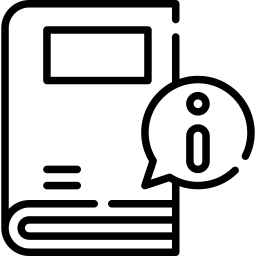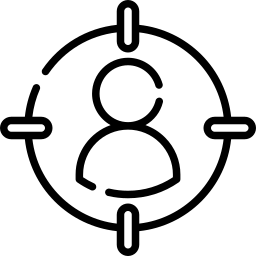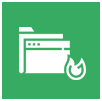Create.com and Imunify: Protecting sites from being blacklisted
The last decade has seen some of the largest data breaches, and the cost to manage and remediate these breaches continues to increase. Google publishes a transparency report highlighting the massive rise in sites flagged as dangerous. Because shared hosting providers maintain thousands of websites, this makes them a primary target for hackers aiming to breach either individually hosted websites or the server hosting their customer sites.
In a web application environment, the first level of defense is the hosting infrastructure. This puts tremendous pressure on shared host providers to install the right cybersecurity appliances across the environment. Shared hosting is unique from dedicated hosting or virtual private servers, as customer websites don’t run in an isolated environment. Any compromise of one customer site could affect the physical server, and this affects the host’s reputation and revenue.
60%
WordPress owns over 60% of the content management software market
35%
of the Internet is powered by WordPress
Hacked Sites and the Google Blacklist
60 trillion URLs
the Google search bot crawls every day
10K websites
daily Google flags as hacked
90%
Google owns almost 90% of the market for Internet search.
When a domain is flagged for hacked content, it’s removed from the index, meaning it no longer shows in results when a user performs a search query. In some scenarios, Google simply places a warning that the site is hacked in search results. Both outcomes will greatly affect a corporate website organic search results and ultimately its revenue.
The effects of being blacklisted are almost immediate. The site owner will see a drop in traffic, as both Bing and Google display a red interstitial message in the user’s browser warning them that the site contains malware. Google owns almost 90% of the market for Internet search, so a website flagged by Google Safe Browser will receive almost no organic search traffic. With this drop in search traffic, the site owner will see residual effects in revenue, lead generation, and customer loss.
How Does the Google Blacklisting Process Work?
Not every site is hacked when Google flags them. Some sites contain malware or facilitate phishing attacks. Google Safe Browsing detects sites with malicious intent and flags them as well. When a user types the URL into Chrome or FireFox(which also uses the Safe BrowsingAPI), they are met with a red warning interstitial.

Google has two main red interstitials shown below.
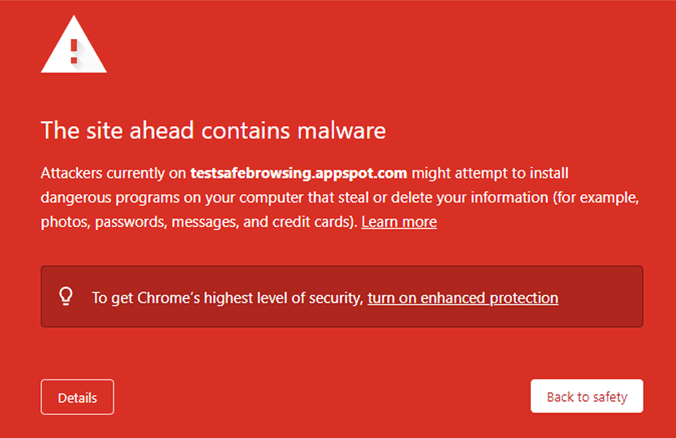
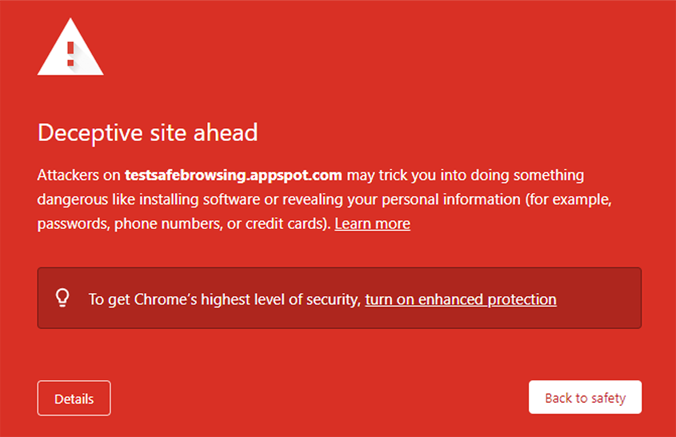
 Google blacklists sites for several other reasons, and each warning interstitial and notification can be seen here.
Google blacklists sites for several other reasons, and each warning interstitial and notification can be seen here.Other Google products can also be affected after being flagged in Safe Browser.
For example, any Adwords ad campaign spointing to sites determined to host malware will be suspended if the issue is not resolved quickly. Some website owners see long-term organic traffic loss even after the issue is resolved. If Gmail accounts are found to send phishing emails to the site, the Google Suite or personal Gmail account could be suspended as well.
Identifying a Blacklisted Website
After the site is registered, it can take a few days to collect and display data, but a notification about the compromised content should show quickly in the “Security and Manual Actions” page.

What Triggers the Malware Warnings?
A few reasons why a site gets flagged
INJECTED CONTENT
If attackers are able to add content to a site’s existing pages, the malicious code can be used to steal data from users or trick them into sending data in attacks such as clickjacking. JavaScript files can also be used to inject malicious content if an attacker can add them to site files.
ADDED CONTENT
Attackers with write access to a server’s directories can upload malicious files unknown to the site owner. Links to the files are then sent to an attacker’s targeted victims. The newly created files can go unnoticed until Google crawlers find them and flag the domain as an attack site.
HIDDEN CONTENT
In spam attacks, attackers inject hidden links into a site page that points to their malicious content. The links can be hidden using CSS and JavaScript, or attackers could display them far down the page so that the site owner does not notice them. This attack is commonly used for pharma spam were hacked sites host hidden links to drug-related sites.
REDIRECT
Conditional redirects send users to a malicious website when users click the website link in Google but not when the site URL is directly entered into a browser. When the website owner or webmaster checks the site by directly typing the URL into Chrome, the site acts normally. These conditional redirects help keep the hacked content hidden from the site owner but redirect users to another page when finding the site in a search engine.
INJECTED CONTENT
Injected content can be anything from a malicious third-party JavaScript file or persistent XSS where the attacker adds links to your site. Persistent XSS content is usually stored in the site database, which means that tables must be cleaned from the malicious content and the offending code snippet remediated.
External files should be stored locally. Should the third-party host be compromised, the scripts included in the site code would be controlled by the attacker.
ADDED CONTENT
with access to directories can upload malware for the site owner to host. By uploading malicious files to numerous compromised sites, an attacker can then use phishing emails to trick users into thinking they are downloading files from a legitimate website. Attackers that aim to inject links and malicious downloads on a site server often work with a mesh of hacked sites instead of just one compromised server. In this scenario, the files are hidden from view when the site owner browses the site, but Google’s crawlers are able to detect them while analyzing site content.
HIDDEN CONTENT
Hiding malicious content is one component of compromising a site. Hackers like to keep their actions hidden from the site owner so that injected and uploaded content will persist. They do this by using conditional coding such as displaying malicious content based on the user agent or the REFERER header value. The hidden content is placed in a div or other HTML element with CSS properties (e.g. the div contains the “display: none;” directive). When users view the web page, they do not see the hidden links, but crawlers detect them.
Cloaked links are an example of hidden content. Pharmaceutical links, referred to as a “pharma hack,” are often injected as cloaked links. Cloaked content refers to web page content that does not display to human users but is injected into a page where crawlers can process the links as backlinks to a specific site. By using cloaked links, the attacker can manipulate search results to better rank sites in Google’s index.
REDIRECTS
Google detects phishing content meant to steal credentials and financial information from targeted users. When sites get caught hosting phishing pages, Google flags them as suspicious. Hackers use third-party sites in several ways to facilitate phishing. The first one is hidden redirects. The redirects are usually configured in the httpd.conf file to conditionally send users to a phishing page based on the REFERER value to avoid detection.
The second way attackers use redirects is based on vulnerabilities on the website. It’s not uncommon for developers to redirect users based on query string values. If the redirects are not whitelisted to ensure that users are only redirected to defined sites, then attackers can use them for their own phishing pages.
For instance, the following URL could be used to redirect users:
https://site.com/?redirect=anypage.com
The redirect query string variable should be whitelisted, or an attacker could use it to launch a phishing attack. When users see the URL, they see an innocuous link to “site.com,” but open redirects allow an attacker to trick users into going to a malicious page. The link would look similar to the following:
https://site.com/?redirect=maliciouspage.com
In the above example, the user would be redirected to the attacker’s phishing page allowing them to trick users into thinking they went to a familiar site.
Web Hosting with Security in Mind
For many webmasters, using WordPress alleviates much of the site management overhead compared to coding a site from scratch. Because of the ease of use with WordPress, the software owns over 30% of the market followed by Joomla and Drupal. The popularity of WordPress makes it great for creatives, but bad for cybersecurity. If WordPress isn’t configured and managed properly, it’s often hacked. As new vulnerabilities are found, a WordPress site and its plugins must be patched quickly.
With Create.com , webmasters have two options for secure hosting

MANAGED WORDPRESS
In a managed WordPress environment, the hoster helps with updates, monitoring, and security for the site. This option leaves the cybersecurity of the site in the hands of the hoster, which is beneficial for webmasters unfamiliar with the way hackers work.

SHARED HOSTING
With shared hosting, the webmaster has full control over the website but leverages the hoster’s server. The hoster’s server security protects the site from a compromise, and provides 99.9% uptime, a 50-day money-back guarantee, solid state drive backup storage, and free unlimited migrations.
In addition to automatically updating WordPress, the site owner should always take regular backups and keep these backups for at least two weeks (30 days are preferable). Backups are critical for disaster recovery and incident response. If malware cannot be removed from a site, backups can be used to restore the database and files. Note though that should malware persist on the site for months, these backups could contain malware and must be properly audited.
The Source of Most Vulnerabilities: WordPress Plugins
In widespread compromises, the plugin author hands over their project to an unknown party who injects malicious code into the plugin code repository. Injected code in a popular plugin can leave hundreds of thousands of WordPress sites open to hackers.
The vulnerability required an immediate update to the newer version, but many webmasters are unaware of CVE notices and leave WordPress sites unattended. When vulnerabilities are made public, attackers scan the web for these specific vulnerabilities and exploit them. After sites are exploited, they host malicious content that Google’s crawlers collect and potentially flag the site in Safe Browsing.
With this Cross-Site Scripting (XSS) vulnerability, an attacker could perform any number of activities in the context of an administrator account when the administrator views a page with these fields.
In April 2020, researchers saw a large spike in scans against WordPress sites for several existing vulnerabilities.
A single bad actor used 24,000 distinct IP addresses to scan 900,000 WordPress sites searching for known vulnerabilities in popular plugins. The attacker then attempted to inject third-party hosted JavaScript code into vulnerable pages that would run when an administrator is authenticated into the WordPress dashboard.
Plugin developers often use the same open-source libraries, so a vulnerability in just one library can affect several plugins. In a large-scale WordPress attack, a single bad actor can affect hundreds of thousands of sites.
Create.com Cybersecurity Focus
Stop Outgoing Spam
Create.com leverages “rspamd,” which is an email spam filter that analyzes outgoing email, determines if it’s spam, and forwards it to an additional anti-spam layer named MailChannels. Email is then sent to the recipient only if the email passes validation. This double validation and anti-spam layers protect the site owner, the provider, and any other customers on Create.com servers.
Secure Migration
During migration, Imunify360 scans the site as files are transferred to the new host server. Imunify360 performs an antivirus scan on all site elements and automatically fixes issues as the site migrates. This unique Create.com migration component is just one example of focusing on security to protect site owners on a shared hosting server.
Six Layers of Security in Imunify360
Imunify360 has six layers of security
It’s estimated that 1/8 of new files stored on a server are malicious. Antivirus is a basic component in cybersecurity but often overlooked in web application hosting. Most webmasters know that desktop antivirus is necessary for local device security, but they are unaware that antivirus is also necessary for web application security.
Imunify360 identifies and cleans malicious content so that site owners
do not need to manually find hacked files.
A standard firewall analyzes and filters all traffic, but a WAF targets HTTP traffic. By targeting HTTP traffic, a WAF can block specific attacks against web applications such as XSS, SQL injection, file inclusion and several others. These attacks are commonly misunderstood and often hidden to webmasters who do not know how to monitor them. Traffic passes through the Imunify360 WAF that then analyzes its content to determine if it’s malicious. If the request passes validation, it’s forwarded to the web application.
In simple applications, blocking all incoming traffic protects the internal network. This configuration is common for home firewalls, but it’s not feasible in a hosting environment that needs advanced analysis for incoming and outgoing traffic.
Imunify360 includes an advanced firewall that uses cloud heuristics and artificial intelligence (AI) to detect threats and block brute-force attacks often used to guess a user’s credentials.
Web security is more than blocking incoming traffic. It also means identifying content on the site that could be silently performing malicious actions. For example, a PHP script injected into the site could be used to send spam emails to targeted recipients. Imunify360 is a proactive defense that adds an extra PHP Security Layer of protection, prevents malware execution in real-time, and ensures multi-level access blocking to malicious PHP files.
Cybersecurity of any application is never a “set it and forget it” event. Software vendors including plugin developers frequently deploy patches to remediate newly found vulnerabilities. To continue protecting a CMS, all plugins and the CMS software must be patched every time a new update is published.
Imunify360 provides proactive cyber-defenses by patching software after developers deploy an update. By quickly patching the CMS, the webmaster reduces the window of opportunity for an attacker.
Imunify360 monitors various blacklists to find out if the domain is delisted from search engines or blocked for malicious activity.
Monitoring domain reputation allows webmasters to quickly remediate any issues should the site be compromised and identified as an attack site that distributes malware, sends spam messages, or hosts phishing content.
Secure Hosting with Create.com


We’re all about layering the services for a cleaner internet and customer experience. Are you with us?
Adam Farrar
Chief Executive Officer of Create.com
Related Articles



Frequently Asked Questions
What is Imunify360?
Imunify360 is a comprehensive security suite for linux web-servers. Antivirus, Firewall, WAF, PHP Security Layer, Patch Management, Domain Reputation with easy UI and advanced automation. Find out more about Imunify360 and how it works here.
What systems do you support?
We support all the popular systems CloudLinux OS 6,7,8, Ubuntu 16,18, CentOS 6,7,8, Debian 7,8,9,10, RHEL 6,7,8
What panels do you support?
We have a simple installation at any of these panels – cPanel & WHM, Direct Admin and Plesk.
What should I do if I do not have a hosting panel?
Imunify360 offers Stand-alone installation. The detailed instructions are available here.
How can I test Imunify360?
You could explore Imunify360’s all set of features free for 14 days on an unlimited number of servers. No credit card information required. After the trial period is over, you can purchase an Imunify360 license via CloudLinux Network (CLN) by logging in to cln.cloudlinux.com.
How can I get technical support for the Imunify Products?
For technical support, visit the Imunify Support Portal. Powered by a Unified Search feature that obtains results across all available resources, this is your 24/7 gateway to all the information you might need to answer your questions or troubleshoot issues.
How do I get started with Imunify360?
Our Getting Started guide will guide you through all the steps of the installation process and help you explore all features of Imunify360.
What is the price of Imunify360?
The pricing of Imunify360 starts at 6 USD /mo. You can find more information about pricing here.
How can I buy Imunify360?
You can purchase Imunify360 either via CloudLinux Network (CLN) by logging in to cln.cloudlinux.com or contact [email protected].
How to become a partner or reseller?
We have created this handy Partner Guide to help you effectively promote Imunify360 to your Shared and VPS customers and accelerate your sales. You can learn more about the Imunify360 partner program here.
Where to find Imunify360’s documentation?
You can find all technical documentation about Imunify360 here.
How can I access the Imunify Products forum?
Visit the Imunify Products forum to get help from the large customer community, as well as senior support engineers.
Documentation
 Imunify360 Features
Imunify360 Features Installation Guide
Installation Guide Introduction to Imunify360
Introduction to Imunify360 Support portal
Support portal
